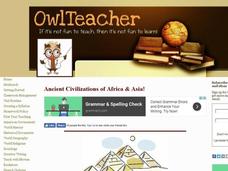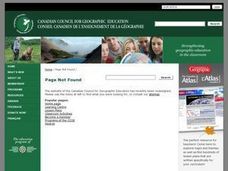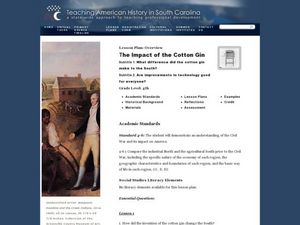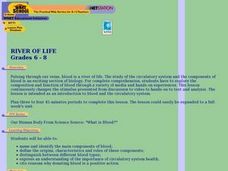Owl Teacher
Teach Ancient Civilizations: Africa
Amazing! Teach learners about the wonders of ancient Africa and Asia with a comprehensive set of teaching tools. You'll click to find a well-constructed presentation, a worksheet that has kids compare and contrast ancient alphabets, a...
NY Learns
Geography of the Fertile Crescent by ECSDM
Using Google Earth, a vocabulary assignment, and map handout, your class members will outline the Fertile Crescent in Mesopotamia and identify the source of the Tigris and Euphrates rivers. They will then complete graphic organizers...
Curated OER
An Empire in the Balance
Eleventh graders investigate the role of New York state during the American Revolution. In small groups, they research a particular region within colonial America, analyze primary source documents, complete Document Analysis Sheets, and...
Virginia Department of Education
The Hydrologic Cycle
There is the same amount of water on earth now as there was when it was formed. The water from your faucet could contain molecules that dinosaurs drank! Young scientists build their own hydrologic cycle model and observe...
Curated OER
Sediment Sleuths
Are you looking for a good, solid lesson on sedimentary rocks? This one, produced by the Illinois State Museum, is just such a lesson. Middle schoolers identify common rocks and minerals by analyzing sediments from local water sources....
Curated OER
Topographic Connections: Earth's Surface Shapes Streams; Streams Sculpt the Earth
Students identify physical characteristics of developing streams and infer changes in the landscape by creating a river model.
Curated OER
Drinking Water and Water Purification
Sixth graders design experiments to compare the amount of bacteria in river water to the amount in purified tap water. They explore how water purification removes bacteria and pollution from the water. Students examine the steps of the...
National Institute of Open Schooling
Heavy Metal Contamination
An informative lesson focuses on heavy metal contamination of environments. Classes read about, discuss, and answer questions pertaining to sources of heavy metals in the environment. To finish the 35th installment of 36, individuals...
Curated OER
T3 Lesson Plan: Number 3
Sixth graders investigate local water. In this water cycle activity, 6th graders take samples from surrounding water sources. Students record data from the samples, compare and graph the results.
Curated OER
Chemical Consequences of Burning Fossil Fuels
Future scientists are introduced to the chemical consequences of burning fossil fuels, learning that fossil fuel combustion leads to the formation of oxides of three nonmetals: carbon, nitrogen, and sulfur, all of which end up in the...
Curated OER
Lincoln's Spot Resolutions
Students take a closer look at historical relations between the United States and Mexico. For this Texas annexation lesson, students examine primary documents authored by Zachary Taylor, James Polk, and Abraham Lincoln to consider why...
Chymist
Testing the Waters
Should you trust the water you drink every day? The hands-on activity has scholars test water from different sources for contaminants. Pupils perform chemical testing and make conclusions about pH, hardness, iron, chlorine, lead,...
Curated OER
Would You Drink This?
Students examine how they affect water quality of those who live downstream after identifying rivers and river basins in Kansas.
Curated OER
Interpreting Photographs
Students examine photographs and complete research on river transportation. They describe the beginnings and innovations of the steamboats. Students research the development of trade from the 1700s through the 1800s. They write a...
Curated OER
The Pros and Cons of Dams
Young scholars investigate the use of dams on rivers in order to manage water uses in particular the Flathead River and Lake. They make presentations about dam management and write a persuasive paper on the issue. If possible they visit...
Curated OER
Map of the Ottawa Valley
Young scholars locate Ottawa Valley on a map. They then answer questions in reference to the map such as: What was the first use of timber in the Ottawa Valley?, What occurred first in Gatineau?, and On the Ontario side of Ottawa River,...
Curated OER
Discovering the Oregon Trail
Students explore U.S. history by researching the Oregon Trail. In this American exploration lesson, students read the story On the Shore of the River and define the exact path early settlers took to find the state of Oregon. Students...
Curated OER
Deerfield Debates Its Future: What Constitutes Progress?
Young scholars explore the many resources that one can use to explore a community, the Colonial Revival movement, and how the industry and technology reshaped life in Deerfield the Connecticut River Valley.
Curated OER
National Road to Indiana
Students explore the National Road to Indiana. In this U.S. highway history and primary source research instructional activity, students read an original journal written by Jane Voorhees Lewis in 1806 describing her trip west on the...
Curated OER
The Impact of the Cotton Gin
Fourth graders study Eli Whitney and the cotton gin. In this lesson plan on the cotton gin, 4th graders use primary and secondary sources to gather information about Eli Whitney, the cotton gin that he invented and how it changed the south.
Curated OER
River of Life
Students explore the composition and function of blood through a variety of media and hands-on experiences. This instructional activity is a very good introduction to blood and the circulatory system.
Curated OER
The Water Cycle and Sources of Pollution
Students make an island that has a construction site on it. They spill siulated pollution and trash on top of the island and then water it to simulate rain. They will observe how the rain washes dirt, sand, and pollution off the island...
Curated OER
Go to the Source- Your Town's Tap Water
Students investigate their town's tap water. In this water quality lesson, students complete a simple taste-testing experiment and online research to investigate tap water.
Curated OER
Rivers to the West
Middle schoolers discuss the Lewis and Clark expedition, and the reasons they may have chosen to follow certain rivers. They list the rivers that start from St. Louis and follow the route of Lewis and Clark. Students trace and label the...

























